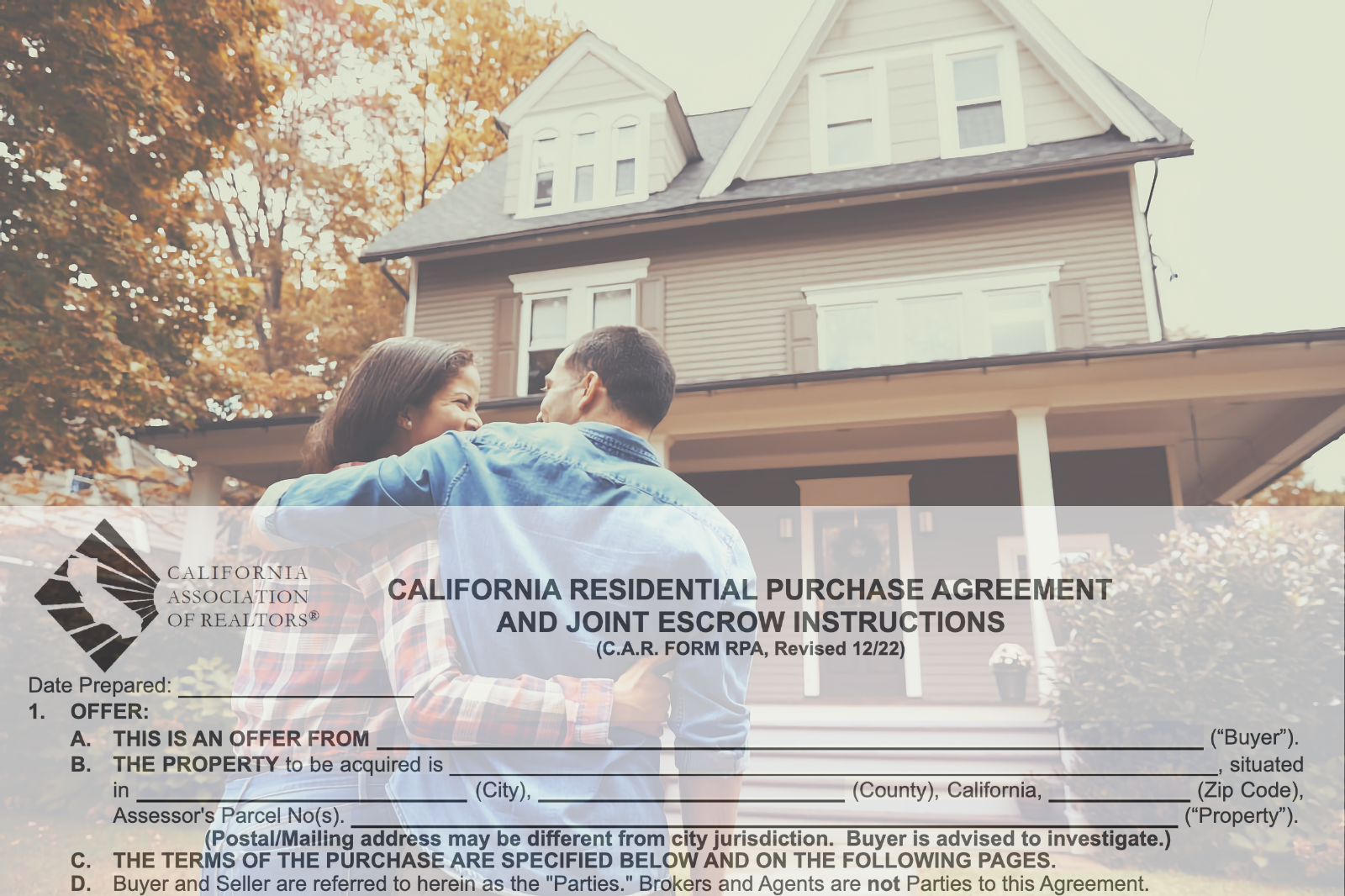Navigating the labyrinth of real estate transactions can be daunting, especially when it comes to understanding the various legal documents involved. One such critical document is the California Residential Purchase Agreement (RPA), the primary contract used in residential property sales in California. Published by the California Association of Realtors (CAR), the RPA is a robust, periodically revised form that sets the terms and conditions of a real estate transaction. This article delves into the intricacies of the RPA, offering insights into its various provisions and the implications for both buyers and sellers.
The California Residential Purchase Agreement is a standard contract which is used in the vast majority of purchases of 1-4 unit residential properties in California. It is updated periodically to reflect changes in the law and custom. The “RPA” can be – and often is – amended with various other disclosures and advisories, along with custom property-and-situation-specific addenda. As a potential homebuyer or seller in California, it’s vital to understand the intricate mechanics of this contract.
This article is designed to highlight a number of important provisions of the RPA, however, all provisions of the RPA are important given everything that is involved in the sale of real estate. Reading this article is no substitute for reading the entire purchase agreement. As buyer or seller, your signature and initials go on this document and it is a legally binding contract. As the RPA is a legally binding contract, you may wish to have the contract reviewed by a qualified legal professional.
Download a sample copy of the California Residential Purchase Agreement Revision 12/22 here:
CAR RPA Sample 12/22
Paragraph 3 – Terms of Purchase and Allocation of Costs
Today’s RPA is 16 pages long but half way down the first page, Paragraph 3 consists of a grid with two and a half pages of fill-in-the-blank terms, which all reference paragraphs later in the contract. This is so that it’s easy to see almost at a glance what the important time periods and dollar figures are, without needing to scroll or flip through he the various pages of the contract. It greatly simplifies reviewing offers when you have multiple offers to review.
Most time periods in the RPA are specified in “number of days” after acceptance. It is possible to write in specific dates, as you may see for example for the closing date. When you are counting days, the day that the offer is ratified (signed by both buyer and seller) is Day 0 – the end of Day 1 is at midnight the day after the contract is agreed to by both buyer and seller.
It is also important to note that any “Scheduled Performance Day” which falls on a Saturday, Sunday, or legal holiday is automatically moved to the next business day. “Scheduled Performance Day” is any day which requires an action by the buyer or seller – e.g. making a deposit, providing documents, or releasing a contingency.
Paragraph 3A (5, 5B): The gross sales price (check “All Cash” under Additional terms)
Paragraph 3B: describes when escrow will close, either a specific date or X number of days after acceptance – which is the date both parties of signed the offer + counter offers. The closing date may be later modified via an addendum if both parties agree.
Paragraph 3C (32A): specifies when the offer expires, either at a specific date and time or a certain number of days after the offer was made.
Paragraph 3D (5A(1)): the amount of the earnest money deposit (“EMD”). By default, Buyer has 3 days after acceptance to deposit these funds into escrow. This deposit, once made, is typically refundable until the buyer releases all of their contingencies for the purchase. If the buyer has no contingencies, the deposit may be non-refundable once it is made, however this is rare.
Paragraph 3D(2) (5A(2)): the amount of increased deposit, which is put into escrow typically after buyer has released all contingencies. When the initial deposit in paragraph 3D (5A(1)) is 3% or higher, there rarely is an increased deposit.
Paragraph 3E(1) (5C(1)): the loan amount the buyer may be using to finance the property.
Paragraph 3G(1) (5E): some buyers will request that the seller pay for some of their closing costs; if so, they will put that here. This will reduce the net cash to the seller at close.
Paragraph 3L(1) (8A): the buyer may have a loan contingency; the buyer must be able to get loan approval to purchase the home, and if for some reason the buyer’s loan is denied, the buyer may cancel the contract and get their earnest money deposit back.
Paragraph 3L(2) (8B): the buyer may have an appraisal contingency; the property must appraise for at least the purchase price; if buyer cancels the contract prior to removing this contingency, they should have the deposit refunded.
Paragraph 3L(3) (8C, 12): specifies how long buyer has for their due diligence or inspection contingency period. This is one of the most important terms of any purchase offer.
Paragraph 3L(8) (8J): specifies if the purchase is contingent upon the sale of another of buyer’s properties.
Paragraph 3P(1) (9): details which appliances and other items which may or may not be considered “real property” are included in the sale. Check this paragraph carefully to make sure there’s nothing included or omitted that shouldn’t be.
Paragraph 3Q (10, 11 13, 19), : this a big block, and deals with closing costs. It specifies who pays for what. Make sure to look at this paragraph carefully as any mistakes here could potentially cost you tens of thousands of dollars.
You will want to pay special attention to Paragraph 3Q(6) which details with Government Required Point of Sale corrective/remedial actions. By custom, the seller usually pays for these items, but they may run into the tens of thousands of dollars, so it is important to know what these costs are before signing the RPA. The type of corrective or remedial actions might be installing low-flow plumbing fixtures, or sewer lateral or septic repairs.
There are of course many other blanks in Paragraph 3’s block of terms, and you should review all of them carefully.
Key Provisions of the California RPA
Initial Deposit and Increased Deposit
The Initial Deposit, outlined in section 3A of the RPA, is a crucial aspect of the agreement. If a buyer wants an unusually long period of time to make the deposit (the default is 3 days), the seller might question the buyer’s commitment to the purchase. This deposit is a sign of the buyer’s earnestness and demonstrates their interest in the property.
In certain instances, the deposit amount may be increased. However, sellers must ensure that a liquidated damages clause is included to cover this increase as per section 3B of the RPA.
All Cash Offer and Loan Contingency
In some cases, buyers might opt for an all-cash offer, which is covered under section 3C. If this box is ticked, section 3H becomes irrelevant and should be omitted.
On the other hand, if a loan contingency exists, the buyer should consider modifying the second and third sentences of section 3J(2). The revised language should make it clear that the lender’s approval of the loan is a contingency of the agreement. It should also specify that if the property fails to appraise at the purchase price, the buyer has the right to cancel the agreement under the loan contingency clause.
Condition of Property and Items Included in Sale
Under section 11 of the RPA, the seller is expected to sell the property ‘as is.’ However, sellers might want to supplement this clause with a more detailed provision, including an acknowledgment that they are not obliged to inquire or investigate any aspect related to the property’s condition.
Occupancy, Title, and Vesting
Occupancy, particularly in the case of tenant-occupied properties, is another critical aspect of the RPA. If the property is to be tenant-occupied after the close of escrow, the buyer should review the lease, perform tenant credit and background checks, and obtain an estoppel certificate during the buyer investigations period.
Title and Vesting, covered under section 7C(2), is crucial for buyers. It is important to ensure that a reputable title company underwrites the owner’s title policy since the value of the title insurance policy depends on the ongoing financial strength of the issuing company.
Solar Systems
It’s important to note that sellers are obligated to provide all known information about the solar panels or solar system. This includes any documentation related to these systems.
Condition of Property (the As-Is Sale)
Paragraph 7B specifies that the sale of the property is “as-is.” This means that regardless of whatever work was done (or not done) to the property at the time that the offer is accepted, unless otherwise specified elsewhere in the agreement, the seller will not have to make any repairs, or issue credits or price reductions to reflect whatever work the buyer may feel the property needs to be done. However, the seller is obligated to maintain the landscaping and grounds until closing:
Unless Otherwise Agreed: (i) the Property shall be delivered “As-Is” in its PRESENT physical condition as of the date of Acceptance; (ii) the Property, including pool, spa, landscaping and grounds, is to be maintained in substantially the same condition as on the date of Acceptance;
It is important to understand that the “as-is” nature of the sale pertains only to the real property itself. But what about the “stuff”? The RPA does specify that the home is to be left free of debris and personal property:
…all debris and personal property not included in the sale shall be removed by Close Of Escrow or at the time possession is delivered to Buyer, if not on the same date. If items are not removed when possession is delivered to Buyer, all items shall be deemed abandoned. Buyer, after first Delivering to Seller written notice to remove the items within 3 Days, may pay to have such items removed or disposed of and may bring legal action, as per this Agreement, to receive reasonable costs from Seller.
The contract does not require that the seller have the property professionally cleaned, however at a minimum I recommend that the property be left in “broom swept” condition so that anything which may be considered “debris” has been removed. Many sellers however will have the home professionally cleaned before they hand over the keys, as a courtesy to the buyes.
Buyer’s Investigation of Property and Matters Affecting Property
Buyers should verify the availability and cost of homeowners’, flood, and fire insurance under the general investigation contingency (12A). For a more comprehensive understanding, a buyer should consider having the property surveyed and visit the local Planning Department for information on planned major construction, zoning, and nonconforming uses.
Although most residential purchase transactions proceed without significant controversy, a small percentage might require dispute resolution. Buyers and sellers who are not willing to accept the risks inherent in relying on CAR forms filled-out by their broker or agent may want to engage legal counsel for document review. This article serves as a guide, for informational purposes only, and is not intended to replace legal advice.
Mediation and Arbitration
In the California Residential Purchase Agreement (RPA), the mediation (paragraph 30) arbitration (paragraph 31) provisions are key elements that outline alternative dispute resolution methods for resolving conflicts that may arise during real estate transactions.
Mediation Provision
Mediation is a preliminary step before arbitration or litigation. It’s a process where a neutral third party, the mediator, facilitates a discussion between the disputing parties to help them reach a mutually acceptable agreement. The mediation clause in the RPA typically requires that before either party can initiate arbitration or litigation, they must first attempt to resolve the dispute through mediation. This process is less formal than arbitration or court proceedings and is often quicker and less expensive. If a party refuses to participate in mediation, or if mediation fails, the parties can then proceed to arbitration or litigation.
Arbitration Provision
Arbitration is a more formal process than mediation and is an alternative to court litigation. In the RPA, the arbitration clause stipulates that disputes will be resolved by an arbitrator instead of going to court. This process is binding, meaning the arbitrator’s decision is final and enforceable like a court judgment. Arbitration can be faster than traditional court litigation and can offer a more private forum for dispute resolution. However, by agreeing to arbitration, parties typically waive certain rights, such as the right to a jury trial and the ability to appeal the arbitrator’s decision.
Both provisions aim to provide efficient and cost-effective means of resolving disputes outside of the court system. They are particularly valuable in real estate transactions in places like the Bay Area, Silicon Valley, and Santa Cruz, where the high stakes and complexities of deals can lead to disputes. It’s important for parties to understand these provisions fully before signing the RPA, as agreeing to them can significantly impact how disputes are handled.
Additional Disclosures in the RPA Package
When your buyer’s agent sends you a purchase agreement to sign, it will almost invariably contain numerous other documents for you to sign. While the RPA itself is “only” 16 pages, the current page count of the total package is currently 26 pages all together. Here is a run-down of the additional documents in the RPA package:
Disclosure of Agency Relationships
In California, the Disclosure of Agency Relationships form is designed to clarify the roles and duties of real estate agents in a transaction. This disclosure is required to be presented to buyers or sellers before signing any other documents to buy or sell property, which is why it is the first document in the RPA package. It is vital as it ensures transparency and helps clients understand the nature and extent of the agent’s fiduciary duties towards them. By signing this form, all parties acknowledge their awareness of these agency relationships, thereby fostering a more informed and trustworthy transaction environment.
Fair Housing and Discrimination Advisory
The Fair Housing and Discrimination Advisory form serves as a reminder and an affirmation of the legal and ethical obligation to adhere to the Fair Housing Act and the California Fair Employment and Housing Act. It outlines the prohibition of discrimination in the sale, rental, financing, or provision of housing based on race, color, religion, sex, disability, familial status, national origin, and other specified characteristics. By providing this advisory to clients, real estate professionals in California ensure that all parties are aware of their rights and responsibilities under these laws. This form not only helps in safeguarding against discriminatory practices but also reinforces the values of inclusivity and equal opportunity in the housing market, which are especially pertinent in diverse regions like the Bay Area and Silicon Valley.
Possible Representation of More than One Buyer or Seller – Disclosure and Consent
In California real estate transactions, the “Possible Representation of More than One Buyer or Seller – Disclosure and Consent” form plays a pivotal role in ensuring transparency and ethical conduct. This document is used by real estate professionals when they (or their brokerage) represent, or might represent, more than one buyer or seller offering or transacting on a property. The form serves to disclose any such dual or multiple representation scenarios to all involved parties and explains the duties and obligations of the Broker in these situations.
Buyer’s Investigation Advisory
The Buyer’s Investigation Advisory form is a crucial document in California real estate transactions, providing buyers with essential guidance on conducting thorough investigations of the property they are considering purchasing. This advisory emphasizes the importance of a buyer’s due diligence in verifying the condition and suitability of the property, beyond the information provided by the seller or seller’s agent. It suggests various inspections and investigations that a buyer should consider, such as physical inspections, title examinations, and reviewing local zoning and building codes. The form also advises buyers to assess neighborhood conditions, schools, and other local factors that could influence their decision.
Wire Fraud and Electronic Funds Transfer Advisory
The Wire Fraud and Electronic Funds Transfer Advisory is a critical document in today’s real estate transactions, particularly relevant in the age of increasing online transactions and digital communications. This advisory serves as a stark warning and guide to buyers, sellers, and real estate professionals about the risks associated with electronic funds transfers and wire fraud. It outlines the common tactics used by fraudsters, such as email phishing and impersonation, to divert funds into fraudulent accounts. The advisory emphasizes the importance of verifying all wiring instructions directly with known and trusted parties, ideally through a phone call or in-person meeting.
Fair Appraisal Act Addendum
The Fair Appraisal Act Addendum is a significant inclusion in California real estate transactions, designed to promote fairness and accuracy in the property appraisal process by insisting on appraisals that are unbiased and objective. The addendum outlines the procedure for challenging and resolving disputes regarding property valuations. By incorporating this addendum into real estate transactions, parties are assured of a more equitable and objective appraisal process. This is especially vital in diverse markets like the Bay Area, Silicon Valley, and Santa Cruz, where fair property valuation is essential to maintaining market integrity and ensuring that all parties are treated justly in real estate dealings.
California Consumer Privacy Act Advisory, Disclosure, and Notice
The California Consumer Privacy Act (CCPA) Advisory, Disclosure, and Notice is an essential document for real estate transactions in California, reflecting the state’s commitment to protecting consumer privacy rights. This advisory informs clients about their rights under the CCPA, a law that gives California residents enhanced control over the personal information that businesses collect about them. In the context of real estate, this includes data gathered during the buying, selling, or leasing process. The advisory explains how clients can access, delete, or opt-out of the sale of their personal information, and it outlines the obligations of real estate businesses in handling this data.
Conclusion
While the RPA is a comprehensive document designed to protect all parties involved in a residential real estate transaction, it’s crucial that both buyers and sellers fully understand their obligations and rights under the agreement. Given the complexity of the document and the potential for revisions, engaging legal counsel for document review may be a wise decision for both parties. Always remember, knowledge is power, especially when it comes to significant transactions like purchasing a home.





